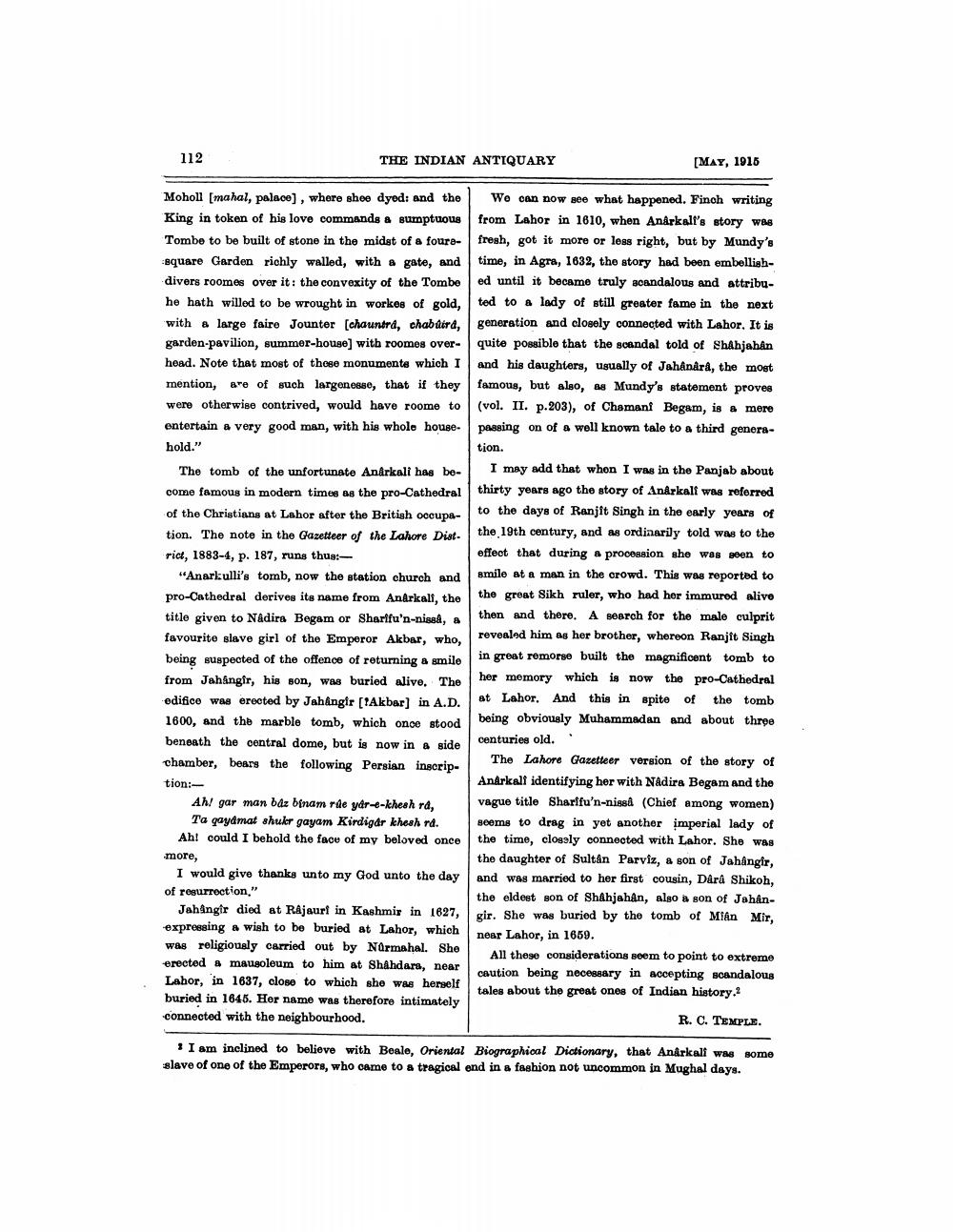________________
112
THE INDIAN ANTIQUARY
[MAY, 1916
Moholl [mahal, palace), where shoo dyed: and the King in token of his love commands a sumptuous Tombe to be built of stone in the midst of a foure- square Garden richly walled, with a gate, and divers roomes over it: the convexity of the Tombe ho hath willed to be wrought in workes of gold, with a large faire Jounter (chaunerd, chabdird, garden-pavilion, summer-house) with roomes overhoad. Note that most of these monuments which I mention, are of such largenesse, that if they were otherwise contrived, would have roome to entertain a very good man, with his whole house. hold."
The tomb of the unfortunate Anarkali has become famous in modern times as the pro-Cathedral of the Christians at Lahor after the British occupation. The note in the Gazetteer of the Lahore District, 1883-4, p. 187, runs thus:
"Anarkulli's tomb, now the station church and pro-Cathedral derives its name from Anarkall, the title given to Nadira Begam or Sharifu'n-nised, a favourite slave girl of the Emperor Akbar, who, being suspected of the offence of returning a smile from Jahangir, his son, was buried alive. The edifice was erected by Jahangir [fAkbar) in A.D. 1600, and the marble tomb, which ono stood beneath the central dome, but is now in a side chamber, bears the following Persian inscription:
Ah/ gar man bäz binam rde ydr-e-khesh rd,
Ta qayamat shulr gayam Kindigar khesh rd. Ah! could I behold the face of my beloved once more,
I would give thanks unto my God unto the day of resurrection."
Jahangir died at Rajaurt in Kashmir in 1827, expressing a wish to be buried at Lahor, which was religiously carried out by Normahal. She erected a mausoleum to him at Shahdara, near Lahor, in 1637, close to which she was herself buried in 1648. Her name was therefore intimately connected with the neighbourhood.
Wo can now see what happened. Finch writing from Lahor in 1810, when Anarkalt's story was fresh, got it more or loss right, but by Mundy's time, in Agra, 1632, the story had been embellished until it became truly scandalous and attributed to a lady of still greater fame in the next generation and closely connected with Lahor. It is quite possible that the scandal told of Shahjahan and his daughters, usually of Jahanara, the most famous, but also, as Mundy's statement proves (vol. II. p.203), of Chamani Begam, is a mere passing on of a well known tale to a third generation.
I may add that when I was in the Panjab about thirty years ago the story of Anarkalf was reforred to the days of Ranjit Singh in the early years of the 19th century, and as ordinarily told was to the effect that during a procession she was seen to smile at a man in the crowd. This was reported to the great Sikh ruler, who had her immurod alivo then and there. A sebrch for the male culprit revealed him as her brother, whereon Ranjit Singh in great remorse built the magnificent tomb to her memory which is now the pro-Cathedral at Lahor. And this in spite of the tomb being obviously Muhammadan and about three centuries old.
The Lahore Gazetteer version of the story of Anarkali identifying her with Nadira Begam and the vague title Sharffu'n-nissa (Chief among women) seems to drag in yet another imperial lady of the time, closely connected with Lahor. She was the daughter of Sultan Parviz, a son of Jahangir, and was married to her first cousin, Dara Shikoh, the eldest son of ShAhjahân, also a son of Jahangir. She was buried by the tomb of Mian Mir, near Lahor, in 1659.
All these considerations seem to point to extremo caution being necessary in accepting scandalous tales about the great ones of Indian history,
R. C. TEMPLE
II am inclined to believe with Beale, Oriental Biographical Dictionary, that Anarkall was some slave of one of the Emperors, who came to a tragical end in a fashion not uncommon in Mughal days.




